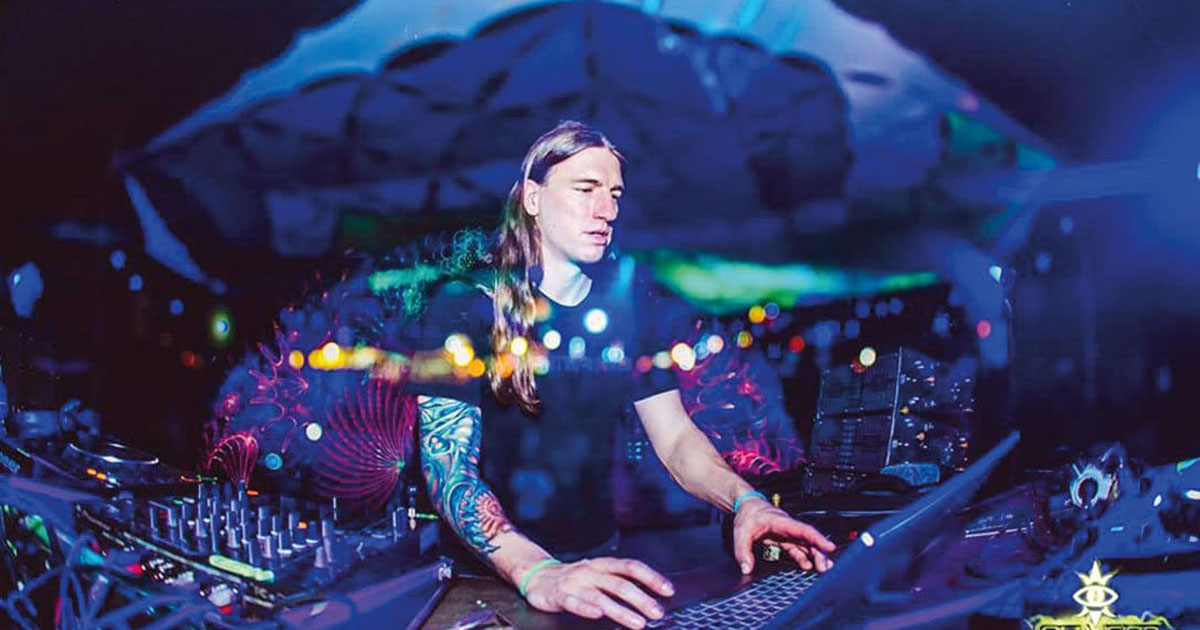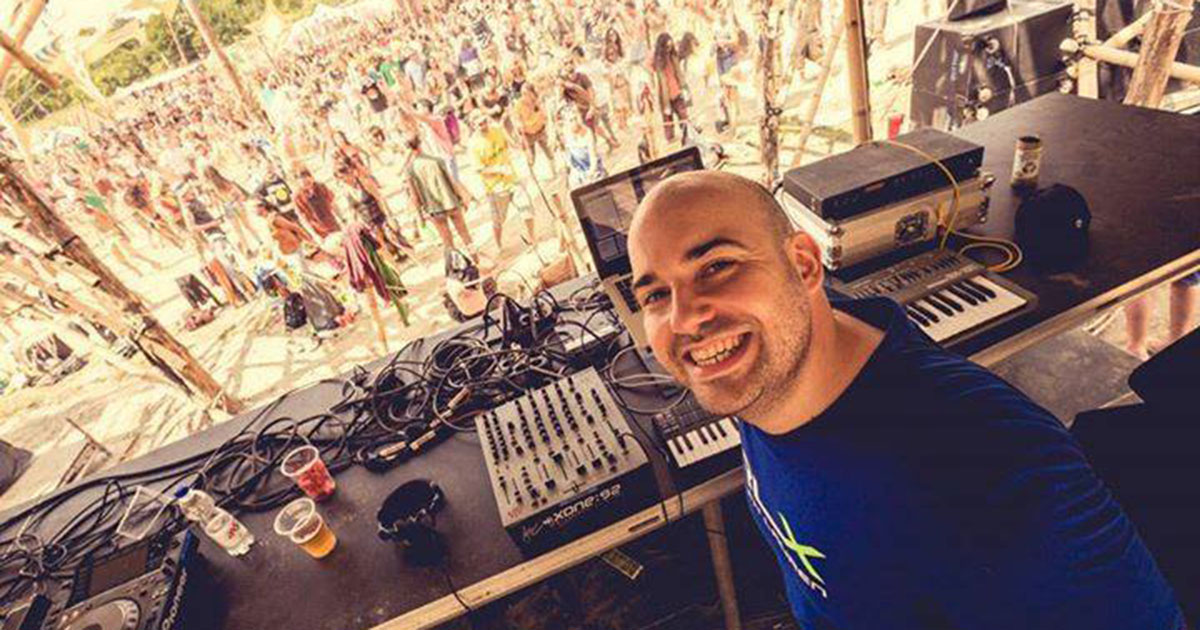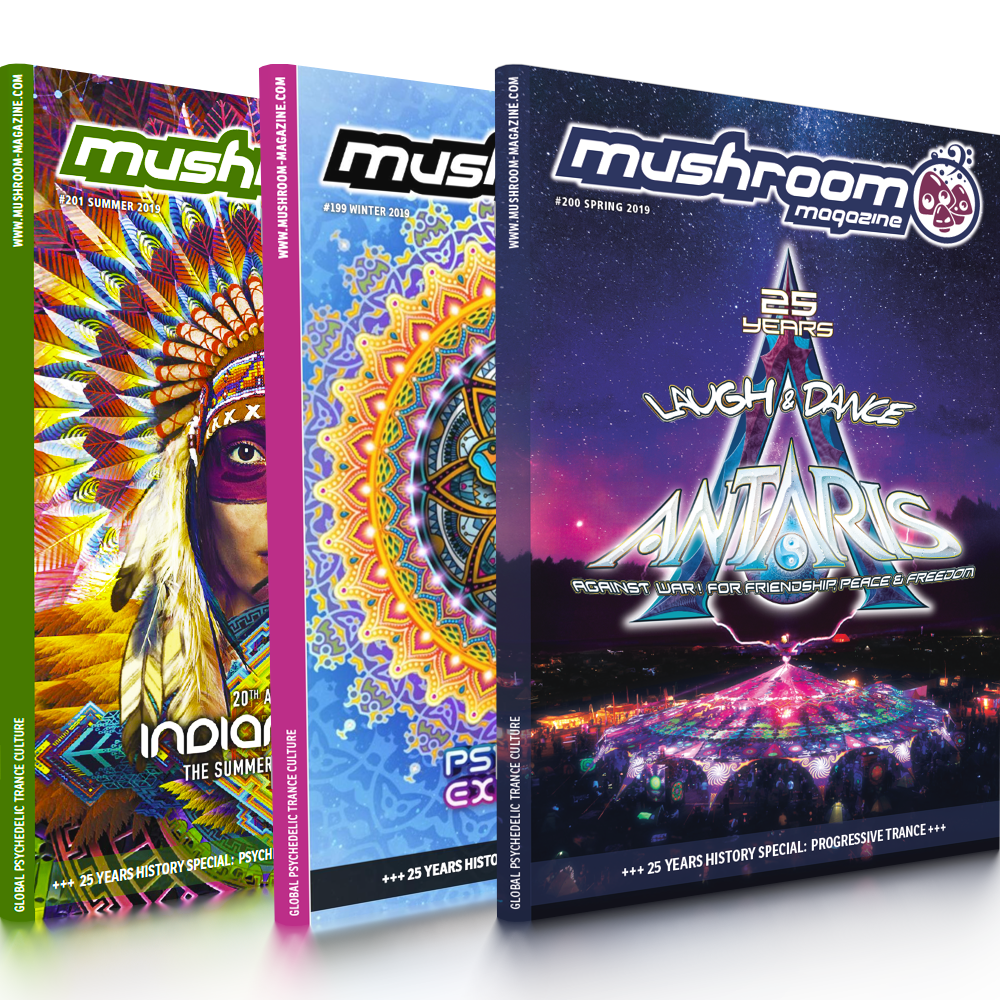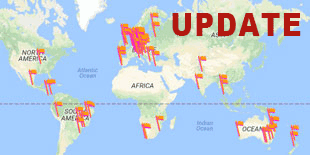Title image: Part of the 2000 mushroom team
It was a very colorful mushroom – a psychedelic mushroom. It was a mushroom that gave joy to party freaks for 25 years.
What began in 1994 as a folded copy for a party series in the North German province developed over the years into an international Psytrance Guide with worldwide distribution – distributed free of charge and supported by many organizations of the Psytrance Community. Since then it has been 25 intensive years. A lot has happened, a lot has been written, but not everything came into the public eye and only rarely did the makers get a chance to speak. Today, Mat Mushroom and the editors of the moving mushroom past, who have often accompanied the magazine for many years, talk. Today you will learn the truths that we often had to conceal.
 Mat:
Mat:
On behalf of the mushroom magazine, we met with a few long-time Shroomies for a talk on the 25th anniversary of the mushroom magazine to review the good old days. Since everything used to be better anyway and we’re getting older, I’m looking forward to the old stories, experiences and anecdotes. Liese, when I came to Hamburg with the mushroom in 1998 and was looking for support, you suddenly stood there in orange (later in red) and accompanied the mushroom magazine with breaks until today – then in sales and in the trance store, but then also editorially, as foreign minister, self-proclaimed spiritual advisor and longobard as well as in the social media sector.
Kai, I’m still grateful today that it rained cats and dogs at this small open air event in the Lüneburger Heide in the mid 90s and that we met at the Chaishop. Your photo art and expressive, unerring articles made the mushroom what it was. You were the spearhead of psychedelic journalism, especially in the magazine’s weddings. Manjula, I would also like to thank you for your work over the last few years – for all the ideas you brought to the mushroom project and for the tireless work with the festival organizers and their promotion in the magazine. Well, precisely because of the cooperation with our festival partners, the magazine is free of charge for the readers. Last but not least, I’m happy that you took over Roberdo, the editorial work for mushroom magazine at a difficult time and kept it going until the final end. All this on a high professional level.
Roberdo, did our big competition have anything to do with you winning the first prize for sending in the best festival concept?
 Roberdo:
Roberdo:
Absolutely! But that was almost 20 years ago, this story with the competition. Christmas 1999: The imaginary festival concept with which I actually took first place was my first text published in the psytrance scene. I also won a DJ CD player that I could never have afforded back then. Both have had a decisive influence on my life story, writing and DJing. In the course of this story I came to mushroom more than 10 years ago as an editor. Looking back, I completely agree with you, Mat. I started as a full-time music journalist when the difficult times just started. There were less and less labels that still had money for advertisements, MP3 and MySpace were big topics, more and more scene actors were more and more worried and concerned about their public image… I don’t want to go too deep now, but the daily business definitely got harder from year to year. And more frustrating for a journalist. During this time I admired how you held out anyway, Mat. Escape to the front. It certainly wasn’t easy for you to throw in the towel after all?
 Mat:
Mat:
I see the whole development somehow with a laughing, a crying and a sarcastic eye. But one at a time. The mushroom had changed from a techno to a psytrance magazine due to the necessity of communication in the scene and was remarkably successful after the techno/psytrance switch. In the 90s the internet was only available for a few nerds and even the music was not reproducible yet. This state of affairs naturally promoted scene magazines like mushroom.
With the advent of music file-sharing, downloads were illegal, but for free. At that time important labels like Spirit Zone or Blue Room disappeared with the bankruptcy of the distributors EFA, Flying UK and Cosmophilia. This pulled the mushroom down quite a bit, because the financing of the magazine, which was distributed for free, was already endangered by the death of the label. An ambitious music journalism of that time, including the wonderful music reviews and articles by Kai Mathesdorf as well as the cool interviews by Alpha, unfortunately became over the following years more and more a promotion booklet with paid articles and little soul, because we had to present them to the customers. Often the most interesting passages were cut away and organizers got agitated, why we would write, for example, that in Germany the weather can be bad. This would be negative for the festival ticket sales. When labels started to stop their promo CD and vinyl deliveries, because we didn’t give them the space we financed in the magazine anymore, I stomped the review section completely. We Are One? Somehow not… or not anymore.
But over the coming years we always found ways to keep at least a part of the free journalism and to open ourselves for the internet; always hoping that there would still be festivals, labels or artists in the community that would follow the WE ARE ONE Mantra. But especially in the last few years the communication of the scene organizations has developed very strongly towards social media, so the mushroom became more and more a supplicant to finance the magazine anew instead of being a magazine and freaky service provider from the scene, which fulfills an important mission for the community.
I’ve been thinking about a sensible exit strategy for mushroom for some time now. It shouldn’t end abruptly in chaos, because there were some annual contracts with our customers that you couldn’t just drive to the wall. So last summer I set the date for May/June 2019 to fulfill all contracts on the one hand and on the other hand to make 25 years mushroom full. It was supposed to be a quarter of a century after all – besides, not everything there was to say was written yet 😉
 Roberdo:
Roberdo:
The big label dying out and the related decline of music journalism… I would like to get into that again. I remember a heated discussion with my good friend Sam, who was doing the online magazine Chaishop.com, where I had just been hired as chief editor. In a review I had torn up the “Techno” compilation of a Mexican label, because it was all good intentions but no skill. Of course the label maker was angry – and Sam wasn’t quite cool with it either, because this label maker was just one of the more and more rare advertisers. That was well over 10 years ago, it was an important lesson for me at that time in terms of “the price of honest journalism”. Kai, you didn’t really have that problem, did you? As a young DJ I always liked to read your very honest and sometimes wonderfully biting reviews in the “Acid Test”.
 Kai:
Kai:
Criticism, whatever the content, is a funny thing. You allow yourself to judge one creative process of another. However: there is definitely ‘good’ as well as ‘bad’ music, whereby the degree of acceptance, i.e. the commercial success, does not necessarily indicate quality. This applies to the relationship between pop and underground music as well as to underground music itself. In addition there is the personal taste, which a reviewer should of course hide, or better: must hide. I found many records recommendable, great and brilliant, although I personally didn’t like them. In principle, it’s difficult to write about music that the reader can’t hear at the moment of reading. So at least the reading itself has to be interesting and entertaining. Music criticism must become its own kind of almost literary art form in order to be read and to create interest for the music discussed. I received a lot of goodwill from my editorial team; only one of my reviews was castrated. With regard to a fully crashed Deedrah/Dado album, I once wrote something about “Ibizan thick beam piss” which my editorial adjudant Claus knew how to prevent. Otherwise I was completely free. When it was more and more about advertisers and finally about paid review space, I had to let it go. You can’t buy my opinion. I’m very grateful for the 12 years I’ve been there. I knew almost every published piece of Psy-Trance from those years and was able to conduct really interesting Eye-to-Eye interviews, which were partly printed over 5 pages. And we had good parties and tours together.
 Roberdo:
Roberdo:
Keyword ‘Good parties’: When was the wedding of the mushroom? When was it the most fun?
 Mat:
Mat:
When I moved to Hamburg with the magazine Projekt in 1998, the whole region including myself was in a psychedelic mood of departure and the parties were just brilliant. Many people came from far away to celebrate at the Gaswerk in Hamburg, for example. The community formed and many freaks just wanted to contribute something to find their place in the scene.
In January 2000 we opened the mushroom trance store in Hamburg Ottensen. This was definitely one of the highlights for me, because with its Blacklight concept it looked like a perfectly decorated Goa party. For a while we invited monthly changing decoration artists to exhibit their pictures and objects in the shop and gave them the cover story in mushroom magazine. The music written about in the magazine was offered in the shop. That went well until the internet was there for everyone and we had to close the shop because of the label crisis already described. Unfortunately there was no online shop strategy at that time.
I also like to think back to our two mushroom Open Airs in summer 2000 and 2003, as well as to the Free Spirit Room Party, which we organized in February 1999 together with Sprit Zone Records and Free Form at Gaswerk.
 Liese:
Liese:
It was a great time – from beginning to end. When music and party becomes your life’s content and you can pay your bills from it, then you just feel like you did everything right. But wedding? In all the years that I’ve actively or more actively looked at it from the outside, it’s always been a dance on the edge and our satisfaction has had a lot to do with our idealistic rather than material goals. Every cent we earned we somehow put back into the book. Better print more pages than drive Rolls Royce. In my time there were the most fat booklets 2003/2004 and it was a horny feeling to push 128 pages to the limits of what was feasible and to experience that the staples could barely hold the center side within the booklet.
 Mat:
Mat:
Sure, Liese, you’re right. The dance at the abyss was always there. But luckily the beautiful things are more likely to get stuck and the dark ones fade.
 Kai:
Kai:
I couldn’t pay my bills and still feel like I did everything right. The years when Mat shot the mushroom from a techno to a psy-trance magazine in 1995/96 were a hot time. Today you draw lines from your smartphone on the mainfloor, in the past every testifying device, especially cameras, was extremely forbidden at parties. I like to remember a 10-day lowest-budget trip with Mat to London, where we visited all the cool labels and also a POF- and a Spirit Zone party. Antaro was on site with his new motorhome, and I sunk a strange, worn chewing gum, which had previously stuck to my camera bag in the dark night, into the infinite softness of his velour cover. That was a horny tour, Raja Ram was only a slightly older man at that time, Blue Room turned the wheel of time, everything was fresh and exciting. We wanted to share what we experienced back then – with mushroom magazine. The best time of the mushroom was certainly around the first ‘intershroom’, when the demand for our information became so great worldwide that we finally had to print English as well.
 Manjula:
Manjula:
My time in mushroom headquarter started late. Which doesn’t mean that this little booklet was unknown to me. I think my first encounter with the magazine was at the VooV 96 in Besdorf. I still lived in Nordhorn, Hamburg and the scene was far away. It was great to find parties from like-minded people for like-minded people and to get to know information about the latest releases and the musicians through interviews etc. In 1998 I moved to Hamburg and from May 2015 I had a desk in the mushroom office. For me the circle had closed. It soon became clear that an alternative non-profit publisher like mushroom magazine needed new distribution channels and ideas. Mat and I spent many hours brainstorming, integrating new clientele, fashion special, Trancers Guide into the summer issue and we reactivated the mushroom on tour events, in any case my personal favourite project. The issues June 2016 and June 2017 were 128 pages strong, all other issues in this time were also full, informative and simply great with 96 pages. But passion and love for music and the scene are not enough to keep a publisher alive. At some point I had to take off my pink glasses due to the words of one of the big European organizers: “Oh dear – you are so old school, nobody wants that paperwork anymore… the world is digital” were sustainable. It was enormously difficult to hear this or similar things in daily telephone conversations. Despite everything, it was a happy time (almost always ‘grins’) I learned a lot in the last years, about the scene, about music, got to know a lot of DJ’s and organizers and now I also know how hard this / our Psytrance / Electronic Music world is competitive. It’s a big business and pink glasses don’t fit there.
 Mat:
Mat:
Of course, the big European organizer is right that the world is now happening online. That’s why we chose the mushroom exit (MEXIT). However, I would have liked the cooperation to have been better in all these years. After all, we did a lot for the scene. But hey, at least at the end of the day we know who our friends are and were.
 Roberdo:
Roberdo:
Music sharing on the Internet was in many ways a great game changer. How did you feel about the advent and consequences of broadband Internet and MP3 back then?
 Kai:
Kai:
In the ‘good old days’ DATs were played by a well-established small circle of DAT DJs who exchanged music with each other. CDs or even mini discs – the first successful conversion of MP3 – were actually inferior in sound due to the lower sampling rates. If you wanted to play CDs, you had to bring your own players with you and you were smiled at at that time. At some point, however, the smileers also wanted to mix, and so all the DJs finally played CDs. And the better sound was suddenly no longer soo important. When in 1997 I bought the ‘500s’, the first small and portable CD player from Pioneer, for a lot of money and was happy not to carry any more vinyl, Mat said to me, there will come a time when the DJ will only bring a check card, which he swipes through briefly to have his complete music available. With USB sticks we’ve almost got there by now. My friend Ole studied sound engineering at a SAE in Berlin at the end of the 90s. He told me how bad MP3s are. I just got an album from Shakta on Dragonfly and gave him a 1:1 Wav copy on CD-R, and a CD-R with the same music, reduced to 128 and blown back to audio format, so the CDs looked exactly the same. Well, Ole had Blue Room Speaker and Sennheiser HD25 headphones and – found the MP3 CD even better because it was more tidy and less trashy. It’s not about the technically maximum possible volume level in all frequency ranges. It’s about music, tone sequences, atmospheres, harmonies and grooves. MP3 has transported music to areas it never could have reached. Without MP3, the PsyTrance culture in South and Central America would not be where it is today.
MP3 is a wonderful tool for democratizing culture. You used to buy a record for 25 Marks, that was a lot of money. You were very limited in your access to music. Today you can listen, stream or load everything. Everything. Anytime. Independent of record store opening hours, availability, etc.. If the DJ is bad, he is simply too lazy to listen to, or simply really bad, because without talent – and should not. Of course a WAV has a higher data density than an MP3. Personally, I can’t tell the difference between WAVs and 320 MP3s even on very good headphones or large sound systems. Nobody who uses JPGs instead of TIFFs says anything bad about it. The basically negative statements about MP3s mostly come from pseudo-elites who earn money with music or don’t want to let their power position be taken away, like the DAT DJs at that time. MP3 is an ingenious invention, already over 25 years old; the patent has just expired, now it is completely free and will invite you to further improve it. Nothing fits better to the culture of Psychedelic Trance than the free availability of music.
As important as labels were as music publishers at analogue times in order to propagate a culture at all, they are almost meaningless today. With many PsyTrance labels I simply don’t see any content or stylistic line anymore. Today labels are only used to promote label DJs and producers. That’s wrong. Digital development will change that. Labels will enter, like the once glorious mushroom magazine right now. Our current internet is a joke and will become one. We live in a very interesting epoch and are witnesses of this upheaval; we should enjoy and use it.
 Roberdo:
Roberdo:
Are there analogies to the general exchange of information on the Internet, in the sense of music journalism? Is there still a need for it today? What do you think?
 Mat:
Mat:
Since good journalism has a value and has to be paid for, but the classic media formats are dying out more and more, public relations takes place in magazines mainly on the websites, social media pages or newsletters of labels and festivals. But here – especially in small organisations – a lot is often done wrong and unprofessionally.
If we now had all the money in the world, an internet portal for the community would be an ingenious project that could be refinanced by the scene to enable high-quality journalism – but you know what? I don’t see a pure financing from the creators of the scene, because every organization would only be concerned with their well-being and would like to talk everything nice. We already had the topic with the “Trancers Guide” project. The slightest criticism was stressful and we stood, for example, between two organizers from one country who couldn’t smell each other – and additionally on the edge of the financial abyss. I really don’t want to have to deal with that kind of stuff.
 Liese:
Liese:
As much as I would like it to be, I fear this scene is not yet ready for really good music journalism. Sure, everyone is looking for promotion, but hardly anyone has more than n’ appeal and an egg to offer. The gap in your head between what is expected and what you are willing to give for it is simply too big. That doesn’t just concern our magazine, the other “fanzines” in other scenes have disappeared from the market long before we do, or have been paid for years.
 Kai:
Kai:
It’s a little too close, I guess. Journalism in general must never be associated with advertising or promotion. The printing costs/online problem, however, affects all journalism today. In the past there was never a photo on the front page of the ‘F.A.Z’, and the ‘mirror’ was 2 cm thick. Today I read on best online addresses really bad and tendentious journalism. One simply gets information from ‘influencers’, those who call themselves that, to be fair, or worse, those who even call themselves journalists. Just doesn’t cost anything. For the user. It costs culture its identity and authenticity. Back then, we received records and CDs a month before release in order to be able to print them in time if the products were in the record shop or could be ordered in the course of the following month. Today you can hear everything immediately. The party-goer 2019 knows sooo much more about music today and knows sooo much because more information and music are directly available to him. Do you still need someone to tell you what’s good? Informative and political journalism will have to endure, but cultural journalism? No. Feuilleton is history. But it was beautiful.
 Rob:
Rob:
So what’s next for you guys?
 Mat:
Mat:
The website mushroom-magazine.com and also the festival map as a central component and the Facebook page as an important channel with its over 330,000 fans will be continued in this or a very similar form. The website actually needs a relaunch urgently, because it is now out of date and also very slow. In order to achieve this, we are thinking about a crowdfunding campaign in which the Psytrance community is involved in the project.
But we still continue with other projects. Many of our readers in German-speaking countries know the Hempedelic magazine, which was distributed together with mushroom until this last issue. We also discontinue this magazine and continue with the website hempedelic.com. Visitors of hemp fairs in German-speaking countries will see our team there even more often, because for some time now we have been distributing the Hempedelic Goodie Bags to the visitors there. There are flyers, small product samples like papers, filters, stickers and other nice gimmicks.
From now on the main project will be deichweb.de. This is an online marketing agency to help offline companies such as shops, restaurants, service providers, but also events with innovative marketing concepts to simply win new customers and guests.
As DJ Mat Mushroom I will only be occasionally available for special events due to the break into new dimensions. I will play the last official gig on this year’s 25th Antaris project, because it just fits so well with the anniversary. Many thanks at this point to Uwe for the invitation.
 Liese:
Liese:
As perhaps the only genuine hamburger here I remember a beautiful sailor quote: “When the wind of change blows, some take shelter in the harbour, while others set sail”. (Unknown)
For a Likedeeler like me, mushroom magazine will always be a port that I like to visit again, because a website and the social media appearances that go with it also need a little maintenance. Otherwise, I’ll just go on as usual, something with media and somewhere between fortune hunter and Robin Hood. Real Hanseats are sought-after (spiritual) advisors worldwide.
 Manjula:
Manjula:
Every ending inherits a beginning (Hesse). Since the mushroom magazine doesn’t disappear completely, but instead of staying ‘old school’ 😉 also goes with the times (finally some people will say 🙂 my home will stay here a bit longer. Otherwise there are 2.3 projects in the pipeline, in due course the social media community will get ‘wind’ of it. So I’m not gone and I’m already looking forward to one last event with mushroom magazine and Juice Club in honour of two deceased mushroom lovers: “A Last Dance”. More info in this issue.
 Rob:
Rob:
I myself have been active in other music scenes for many years and now I’m also putting quite different stories into the keys… I generally need a lot of variety in my life. I quickly get bored. For me it has never been an “achievement” to go to the same festival every year for 20 years or to play at the same festival every year. On the contrary – the older I get, the more depressing I find such life plans. Again a question to my favourite editor, Kai: Did you have moments over the years when the music, the parties, the topics of conversation of the scene seemed like a loop to you?
 Kai:
Kai:
Fortunately I was able to get to know PsyTrance in different countries and scenes. So you see other people and other energies in different time frames. And loops are created less, differently or later. In the past many things were better, but many things were also much worse. PsyTrance is stronger than ever as a scene worldwide. The digital techniques in line with the general social frustration will contribute to even more greatness. Music production technology is constantly improving. But at the moment I miss really good Psy-Trance. Since 2016 this – our – music is dying, everything is only designed for effects and endless drum rolls, for the increase of over-known structures. A new visionary like Cosma is missing. Even Astrix – yes, he used to be great – now complains on Facebook about boring music at parties… ‘Music is the key’ …, and still is. I think Psy-Trance will slow down in the medium term and merge with Techno and House again. There is already music in these areas that is far more psychedelic and ‘tranciger’ than what we commonly call Psy-Trance at the moment. The barriers have been breaking down for years; Stan Kolev and Matan Caspi at the last Halfmoon Festival are a visible step forward. The festival celebrations with electronic, psychedelic music will never end, but the Goa myth will receive a much needed musical upgrade.
My vision of Psychedelic Trance as a concept was that of an alternative society. It was about freedom and renewal – and still should be. The world of Psychedelic Trance should be a role model and be able to transfer free values and systems into the traditional bourgeois world. Unfortunately, after almost 30 years, this is less and less the case. It doesn’t make sense to simply transport business models and personal interests for ‘wealth optimization’ into this free space, to fill one’s pockets and to financially abuse the interest of a spiritual experience of the guest. This applies both to musicians who knowingly have already passed their zenith and who, like aging politicians, simply can’t resist standing on stage. This applies to labels that release music that promises them short-term commercial success, but contradicts your philosophy. This also applies to those promoters who have lost their balance. I currently see too many iron fences, ATMs and payment systems at parties. Another big evil are these disgusting psy-booking agencies that paste the planet with the eternally same, incestuous, unified party music garbage and almost suffocate the scene. Personally, I prefer to hear good DJs who can define themselves from an endless pool of music than the hundredth time old tracks from the few LPs and EPs from some live headliners who always and everywhere do their only conditionally charming show. Still, I’m happy about where we are now; we’ve come a long way. And for those who think that spirituality is generally no longer there, let’s say that you don’t buy it with a party ticket; the Spirit is you and in the happiest case together with people on the same frequency. But with the ticket you buy, you decide which system you want to support and if and to what extent you want to watch the Spirit sell out.













